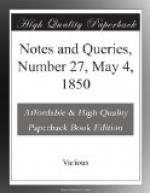savages could make upright scratches on the face of
a rock, and set them in a row, to signify units; and
as the circumstance of having ten fingers has led
the people of every nation to give a distinct name
to the number ten and its multiples, the savage would
have taken but a little step when he invented such
a mode of expressing tens as crossing his scratches,
thus X. His ideas, however, enlarge, and he makes
three scratches, thus [C with square sides], to express
100. Generations of such vagabonds as founded
Rome pass away, and at length some one discovers that,
by using but half the figure for X, the number 5 may
be conjectured to be meant. Another calculator
follows {434} up this discovery, and by employing [C
with square sides], half the figure used for 100,
he expresses 50. At length the rude man procured
a better knife, with which he was enabled to give a
more graceful form to his [C with square sides], by
rounding it into C; then two such, turned different
ways, with a distinguishing cut between them, made
CD, to express a thousand; and as, by that time, the
alphabet was introduced, they recognised the similarity
of the form at which they had thus arrived to the
first letter of Mille, and called it M, or 1000.
The half of this DC was adopted by a ready analogy
for 500. With that discovery the invention of
the Romans stopped, though they had recourse to various
awkward expedients for making these forms express somewhat
higher numbers. On the other hand, the Hebrews
seem to have been provided with an alphabet as soon
as they were to constitute a nation; and they were
taught to use the successive letters of that alphabet
to express the first ten numerals. In this way
b and c might denote 2 and 3 just as well as those
figures; and numbers might thus be expressed by single
letters to the end of the alphabet, but no further.
They were taught, however, and the Greeks learnt from
them, to use the letters which follow the ninth as
indications of so many tens; and those which follow
the eighteenth as indicative of hundreds. This
process was exceedingly superior to the Roman; but
at the end of the alphabet it required supplementary
signs. In this way bdecba might have expressed
245321 as concisely as our figures; but if 320 were
to be taken from this sum, the removal of the equivalent
letters cb would leave bdea, or apparently no more
than 2451. The invention of a cipher at once
beautifully simplified the notation, and facilitated
its indefinite extension. It was then no longer
necessary to have one character for units and another
for as many tens. The substitution of 00 for cb,
so as to write bdeooa, kept the d in its place, and
therefore still indicating 40,000. It was thus
that 27, 207, and 270 were made distinguishable at
once, without needing separate letters for tens and
hundreds; and new signs to express millions and their
multiples became unnecessary.




